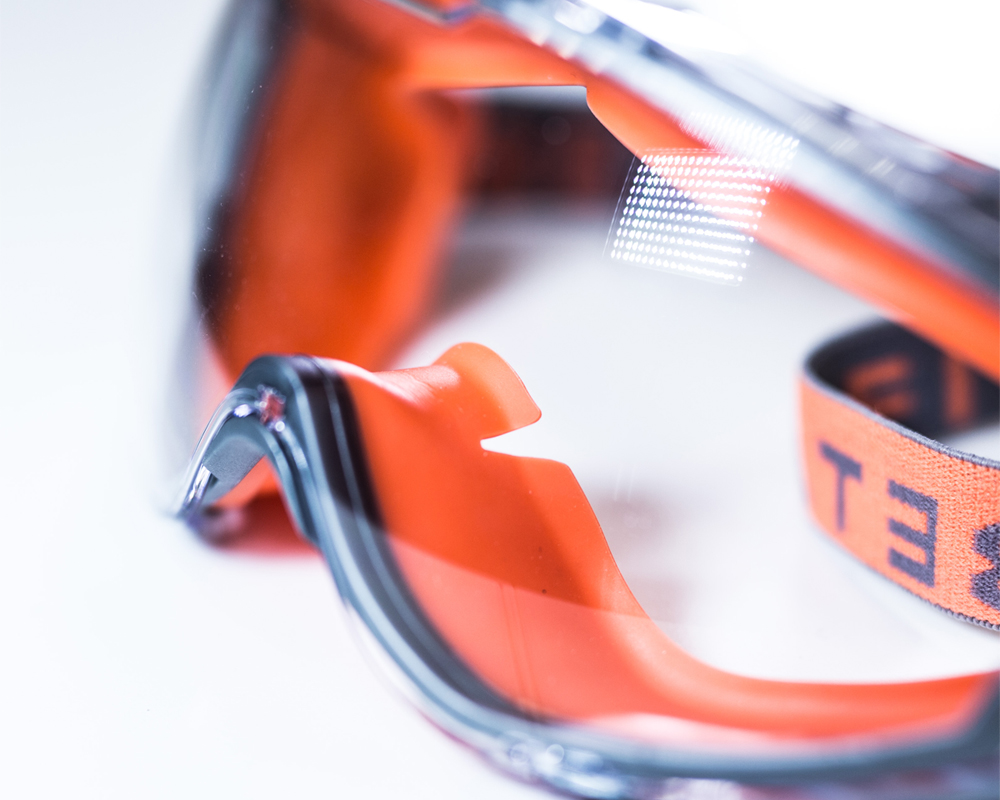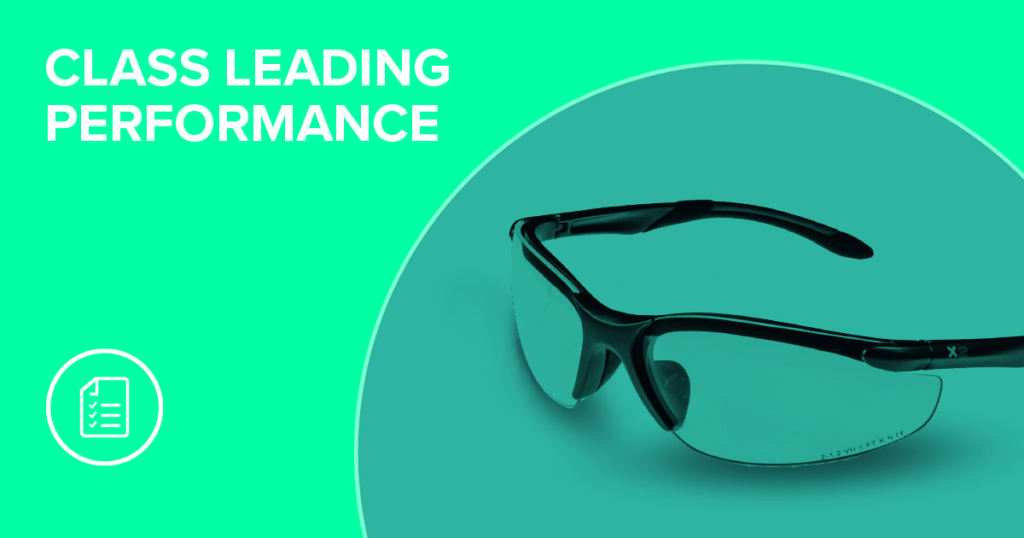Protective glasses offer eye protection against flying objects, for industries that need low impact protection. Some safety glasses feature anti-mist and anti-scratch lenses, as well as different tints for different purposes such as amber tinted lenses to enhance vision in low-light areas, smoke grey tinted lenses to enhance vision in bright sunlight or even a light green lens providing high definition clarity, ideally suited for eye protection whilst in the vicinity of welding. Eye goggles are also a great way to provide eye protection against splashes as they form a seal with the wearer's face.
Eye protection is vital to employee safety as it protects against dangerous hazards that could cause injuries and disease to someone's eyes. Potential hazards include chemical or metal splash, dust, projectiles, gas, vapour and radiation.
According to the American Academy of Ophthalmology, 90% of eye injuries could have been prevented or lessened in severity if the correct eye protection was used.
Failure to use the correct eye goggles could result in chemical eye burns, irritation and inflammation caused by foreign bodies, blunt trauma, allergic conjunctivitis and eye diseases. In extreme situations, eye injuries can even lead to loss or impairment of vision.
The impact of a lack of adequate eye protection at work is obviously (and most seriously) the risk of damage to employees’ vision but other impacts can include days off work or hefty fines for health and safety breaches.
In 2014 Edinburgh-based firm Viridor Enviroscot was fined £165,000 after a worker was left blind in one eye when he was struck by a piece of high-tensile wire. After the case, HSE inspector Aileen Jardine said: "The simple act of donning eye goggles before working with high-tensile wire may well have prevented this incident taking place.”
The simple step of supplying eye protection can keep small particles from entering employees’ eyes, protecting them from chemical splashes, heavy impact (polycarbonate protective glasses are particularly good for this) and some are even designed to be heat resistant.
Protective glasses or eye goggles should be worn in any situation where eye injury is a possibility. A risk assessment should be carried out to identify potential hazards and how they can be controlled. If there are no alternative ways to remove or control the hazard, eye protection should be worn.
It is the employer's responsibility to provide eye protection for the employees. Employers should also make sure that they choose the safety eyewear carefully and ensure employees know how to detect and report any faults.
To decide which PPE would be best to use for a particular job, purchasers should explain the details of the job to their PPE supplier and they can then advise on which eye protection is appropriate.
Here at BETAFIT, this is something we have a great deal of experience with and we always go out of our way to ensure superior comfort and fit as well as total legal compliance. We have an extensive safety eyewear range of protective glasses and eye goggles for you to choose from.
Health and Safety Executive (HSE) advises employers to “make sure the eye protection chosen has the right combination of impact/dust/splash/molten metal eye protection for the task and fits the user properly.”
Ensuring that eyewear fits the user properly is a key focus here at BETAFIT, with our protective glasses actually being designed for wearers by wearers and (as a result) regularly outperforming regulation requirements and providing class-leading performance.
Safety goggles encase the area surrounding the eyes and are to be used for areas with dust and airborne debris.
Eye goggles are often used as science goggles or lab goggles for protection against chemical splash, and for any situation where more than just impact protection is required.
Eye goggles are used by industries that need eye protection from impact, chemicals and other hazardous substances.
Safety over-glasses are designed to fit over normal prescription spectacles for those who require their eye protection to complete the task they are performing. Overspecs are also used by industries that need to protect the entire eye from impact, chemicals and other hazardous substances.

It may come as a surprise, but there are no health and safety laws or legislation that dictate when and where eye protection or eye goggles must be worn.
However, the regulations do say that personal protective equipment is required if there is a real risk that could be prevented by using PPE. PPE is used as a blanket term that would include safety eyewear if it is a suitable form of protection for a certain situation.
The Personal Protective Equipment Regulations 2002 and The Personal Protective Equipment at Work Regulations 1992 give the main requirements for PPE, which includes safety glasses and eye goggles.
Other special regulations cover hazardous substances (including lead and asbestos), and also noise and radiation such as The Planning (Hazardous Substances) Regulations 2015 and The Ionising Radiations Regulations 2017.
The Personal Protective Equipment Regulations 2002 briefly mention eye protection under “2.3 PPE for the face, eyes and respiratory tracts.” The regulations outline some of the legal requirements for eye protection:
All BETAFIT eye protection products are tested to the highest standards in accordance with the relevant up-to-date Health & Safety legislation.
Safety glasses will never permanently hurt vision, however, using the wrong type of safety glasses such as the wrong tint or wrong fit - or if the glasses have poor optical clarity or scratched lenses - could lead to eye fatigue causing soreness of eyes, headaches, and possibly blurred vision.
This is why the BETAFIT eye protection and eye goggles range have been designed to meet the class one optical clarity requirements, so you can trust that they will not harm your vision, and in many cases, different tinted lenses can actually enhance your vision.
Safety glasses are generally one of the more inexpensive types of PPE. The more basic safety glasses we sell start at just 90p per pair.
More advanced glasses that offer unique features for increased eye protection and usability such as Xpolar, Smoke Grey Polarised Anti-Glare Safety Eyewear, cost only £18.42 per pair.
For most companies this is a simple investment to ensure legal compliance and compliance from employees, safeguard their reputation, and (perhaps most importantly) maintain the health of employees.

Polycarbonate is used for safety glasses and eye protection because of its high impact resistance and low weight.
It's also 250 times more impact resistant than glass and is half the weight, making it much more comfortable to wear and making it much more effective at protecting the wearer from an impact.
Polycarbonate can also be modified with abrasion-resistant coating to make it more resistant to scratching and hazing, whilst maintaining optical clarity. Polycarbonate also has great heat, weather and UV ray resistance so is perfect for eye protection.
According to Wikipedia, the Inuit and Yupik people carved snow eye goggles from caribou antler, wood and shell to help prevent snow blindness. The safety glasses we know today were created in 1914 by Garret Morgan as part of his gas mask invention.
BETAFIT manufactures high-quality and value for money eye protection focusing on superior comfort and fit, class-leading performance, and total compliance with relevant legislation.
BETAFIT’S comprehensive range of safety eyewear all meets the class 1 optical clarity requirements of EN166 for wearing safely all day long. The BETAFIT X2 range of safety eyewear was created to exceed the extra stringent requirements of EN166:2002, including K, N & T ratings. The range includes high-quality eye goggles, overspecs, anti-mist, anti-scratch and tinted eye protection, and even welding glasses.
Get in touch with BETAFIT today, call us on 08455 444 000, email us at sales@betafit.com or fill out our online contact form.
This article was written by the Technical Team at BETAFIT PPE, based in Lincolnshire.